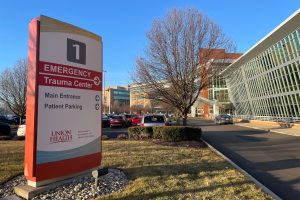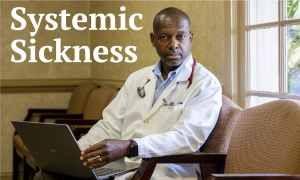Project ECHO GEMH: Disruptive Technology For Geriatric Mental Health
New York State is a leader on many health fronts, whether it be antismoking, obesity reduction, or insurance coverage. But our state is also a leader in another area: we are among the states with the greatest shortages in physician supply. According to the Healthcare Association of New York State, the deficits are especially large in rural areas, which lack both primary care physicians and specialists. This situation hits particularly hard in rural communities since primary care doctors may be their only source of health services, including those for mental health. The prevalence of mental illness is not much different in rural and urban areas, but the lack of access to and availability of mental health services are particular challenges in rural areas. According to the American


New York State is a leader on many health fronts, whether it be antismoking, obesity reduction, or insurance coverage. But our state is also a leader in another area: we are among the states with the greatest shortages in physician supply. According to the Healthcare Association of New York State, the deficits are especially large in rural areas, which lack both primary care physicians and specialists. This situation hits particularly hard in rural communities since primary care doctors may be their only source of health services, including those for mental health.
The prevalence of mental illness is not much different in rural and urban areas, but the lack of access to and availability of mental health services are particular challenges in rural areas.
According to the American Association of Family Practitioners, although mental health professionals are a key component to a patient’s total health, patients are more inclined to disclose signs of mental illnesses to primary care doctors. Yet, primary care physicians can be inadequately equipped to manage patients with behavioral health issues and have little access to back-up resources. For example, 93 percent of primary care physicians describe their problematic access to and communication with mental health specialists (in particular geriatric psychiatrists) as impediments to effective care for patients with dementia. As a result, primary care doctors may hesitate to diagnose and treat older adults in need of mental health care since this is not their area of expertise.
Exacerbating this problem is the following scenario: It is estimated that from 2000 to 2030, New York State’s older adult population will double, and the number of senior citizens with mental illness and dementia will grow dramatically. According to the New York State Office of Mental Health, the number of adults age sixty-five years or older will rise from 2.5 million to almost 4 million. The number of older adults with mental illnesses, including dementia, in the state will climb from 495,000 to 772,000. The costs associated with inadequate mental health and dementia care are profound. In 2013, the estimated cost of health care in New York State for all patients with dementia was $742 million.
Recognizing the impact of this “Silver Tsunami,” in 2014, the New York State Health Foundation awarded a $344,484 grant to the University of Rochester Medical Center to launch the Extension for Community Healthcare Outcomes in Geriatric Mental Health (Project ECHO GEMH) model to enhance primary care capacity to provide geriatric mental health services in rural and underserved communities of New York State.
Project ECHO, which originated at the University of New Mexico, is an innovative model of health care education and delivery that substantially improves the treatment of chronic and complex diseases for rural and underserved populations. Initially designed for patients with hepatitis C, Project ECHO has attained impressive results and has been adapted to numerous additional conditions including cancer, chronic pain, substance use, women’s health, diabetes, and HIV/AIDS.
In general, the ECHO model uses web-based videoconferencing to create “virtual grand rounds.” It connects specialists located at academic medical centers to rural primary care physicians. Through biweekly videoconferencing, didactic presentations, and case-based learning, specialists help primary care physicians develop expertise in a specific field, which they can then apply to patients at their clinic. As a result, primary care doctors deliver best-practice care to their patients, and the need to refer them to specialists is reduced.
With Project ECHO GEMH, the University of Rochester Medical Center will serve as an academic “hub” and will connect a team of its geriatric mental health specialists from medicine, nursing, social work, psychology, and pharmacy to “spokes” made up of primary care sites and individual providers. The only technology required on the part of the participating spoke site is access to the Internet and any device with a camera—a laptop, a webcam, a tablet, or even a cell phone. Led by Yeates Conwell and Michael J. Hasselberg, the project at this medical center will operate two-hour, biweekly TeleECHO clinics, which offer case-based educational experiences for community providers.
Given the projections of increased numbers of older adults and older adults with mental illnesses in New York State, and the long wait times to see specialists, the University of Rochester Medical Center is experiencing a high demand from primary care physicians. As of this writing, twenty-nine sites throughout rural upstate New York have expressed interest in participating in the pilot. If this trajectory continues, we will meet our goal of 175 rural primary care providers trained to provide better care for late-life mental disorders and dementia. Through Project ECHO GEMH, the expectation is that the quality of the care that the primary care doctors deliver will improve, costs of care will be reduced, and provider satisfaction will be high.
When Sanjeev Arora, the founder of Project ECHO, gave a presentation to the University of Rochester Medical Center and other stakeholders in Rochester, New York, he espoused the simplicity of the model. But, as with any “disruptive innovation,” there were some unanticipated challenges in the beginning of this New York project. For example, ensuring the compatibility of telecommunication systems for the sites required more work than originally envisioned. But in the end, none of the challenges were insurmountable, and the lessons learned from the experience have proven to be invaluable for work going forward.
Since the launch of ECHO GEMH there have been two important developments that may accelerate interest in the model. The first is the New York Department of Health’s Delivery System Reform Incentive Payment program’s specific encouragement to use the Project ECHO model (for various conditions) in its “Expand Usage of Telemedicine in Underserved Areas to Provide Access to Otherwise Scarce Services” application instructions.
The second is Gov. Andrew Cuomo’s (D) recent signing into law of legislation that requires insurers, including New York State’s Medicaid program, to cover telehealth services. It’s still too early to gauge the impact of these two developments, but at the very least, it highlights the momentum Project ECHO and other telehealth models are experiencing throughout New York State.
Other Health Affairs GrantWatch content about Project ECHO:
“Project ECHO Is Awarded $6.4 Million Grant For Diabetes And Endocrinology Care To New Mexico Underserved,” by Tracy Gnadinger, July 23, 2014.
“A Workforce That Can Do More: Project ECHO At Ten Years Brings Behavioral Health Care To Underserved Areas,” by John Lumpkin of the Robert Wood Johnson Foundation, July 8, 2013.
Health Affairs article on Project ECHO:
“Partnering Urban Academic Medical Centers And Rural Primary Care Clinicians To Provide Complex Chronic Disease Care,” by Sanjeev Arora and coauthors, June 2011 issue. (free abstract)
Another Health Affairs GrantWatch blog post by Brian Byrd:
“Improving The Accuracy Of Wikipedia’s Medical Information,” December 9, 2014.
SOURCE: Health Affairs Blog – Read entire story here.








